Schiacciata is a type of flatbread from Tuscany, Italy.
It will remind you of focaccia but will be thinner, crunchier, and more like a thick pizza.
Our no-knead schiacciata recipe is easy to make at home. It uses simple ingredients such as flour, olive oil, water, salt, and yeast.
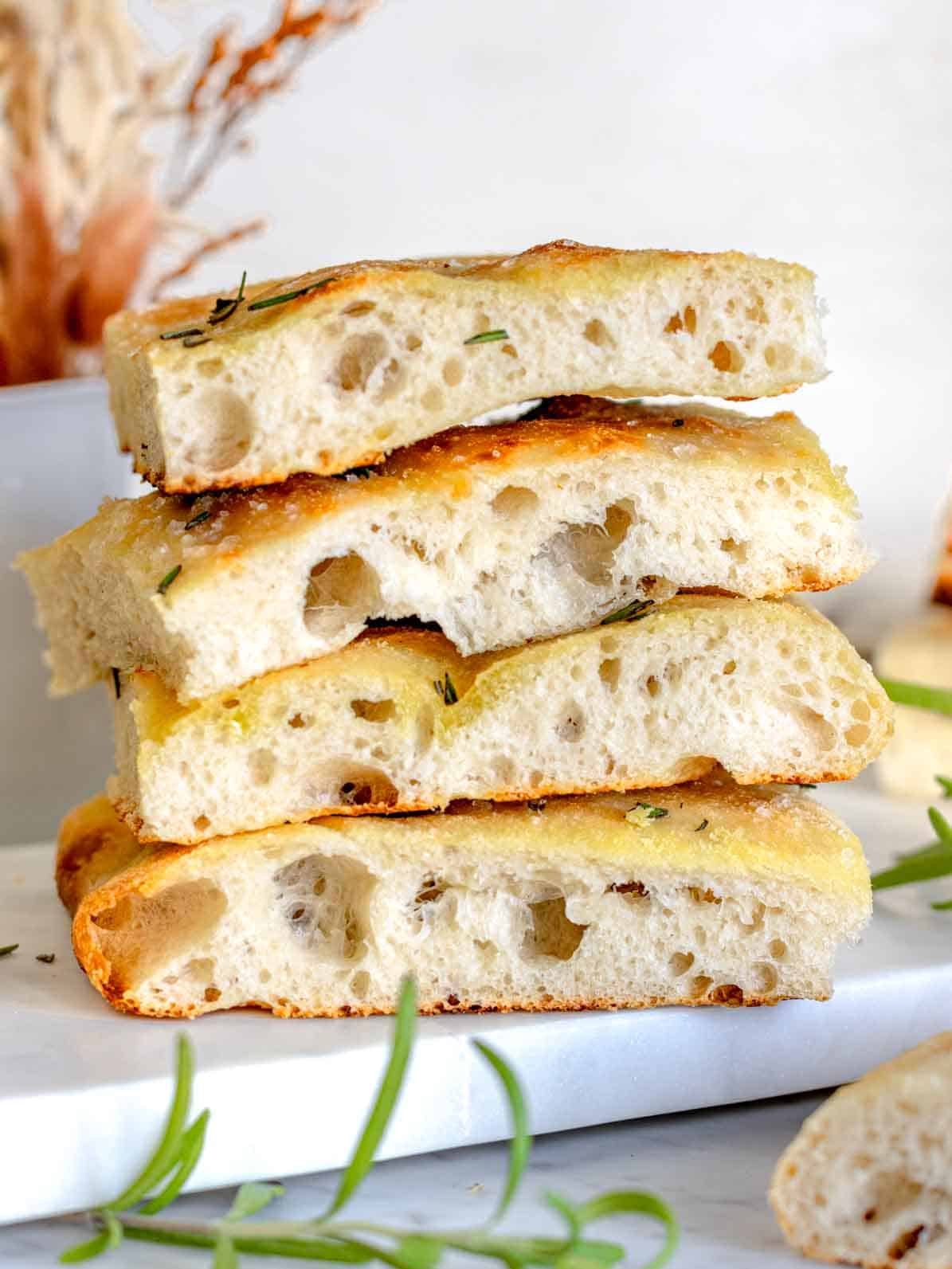
What is schiacciata?
Schiacciata, pronounced SKJAT-TJA-TA, is a type of flatbread from central Italy. The word means compressed, pushed, or flattened.
You’ll love our schiacciata recipe because it’s easy to make in one bowl without kneading. It also has a satisfying, chewy texture and an irresistible flavor.
The recipe is similar to our popular no-knead focaccia recipe. The main difference between schiacciata and focaccia is how the dough is shaped.
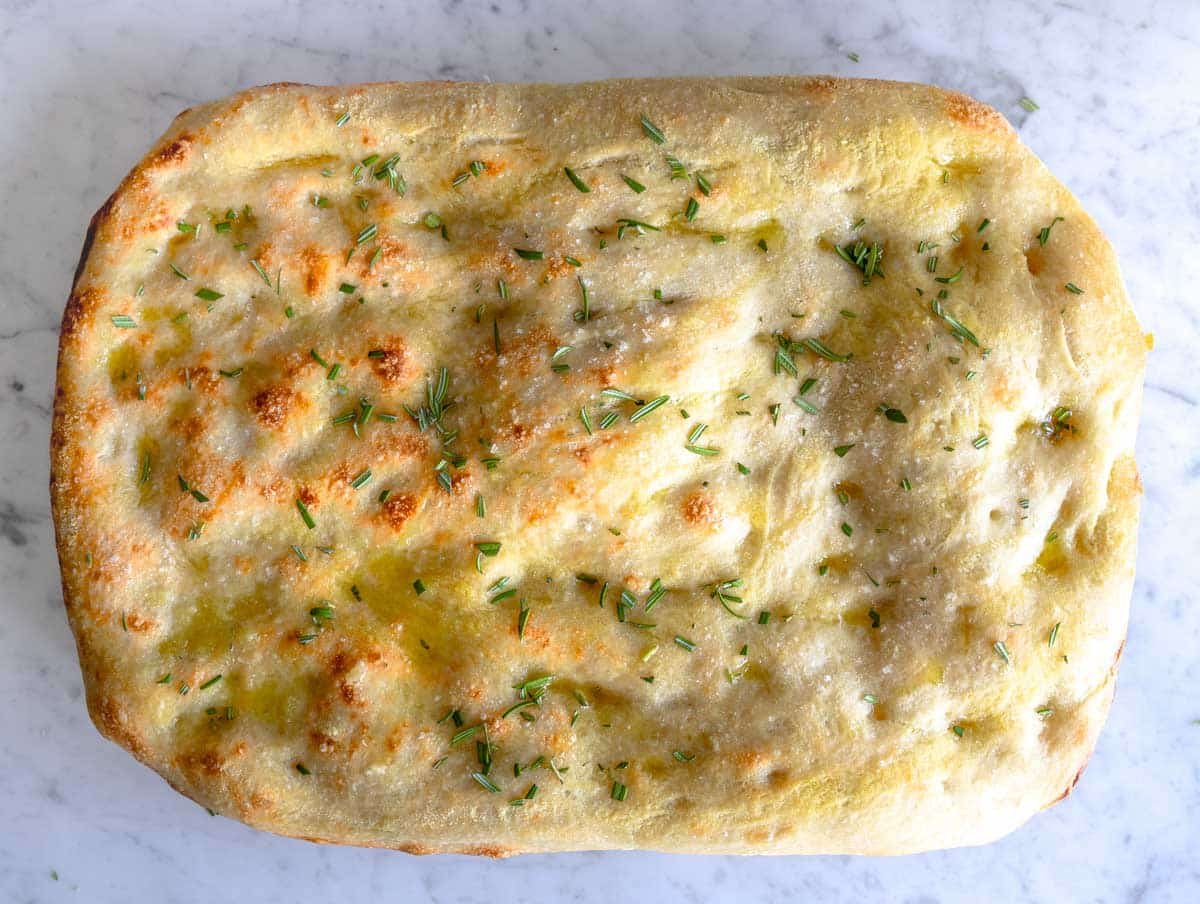
While focaccia is thick, spongy, soft, and cooked in a smaller pan, schiacciata is thinner, crunchy around the edges, and chewier, and you want to cook it in your largest baking tray.
Like most Italian flatbreads, you can top your schiacciata with extra virgin olive oil and salt or add rosemary for a rustic Tuscan countryside touch.
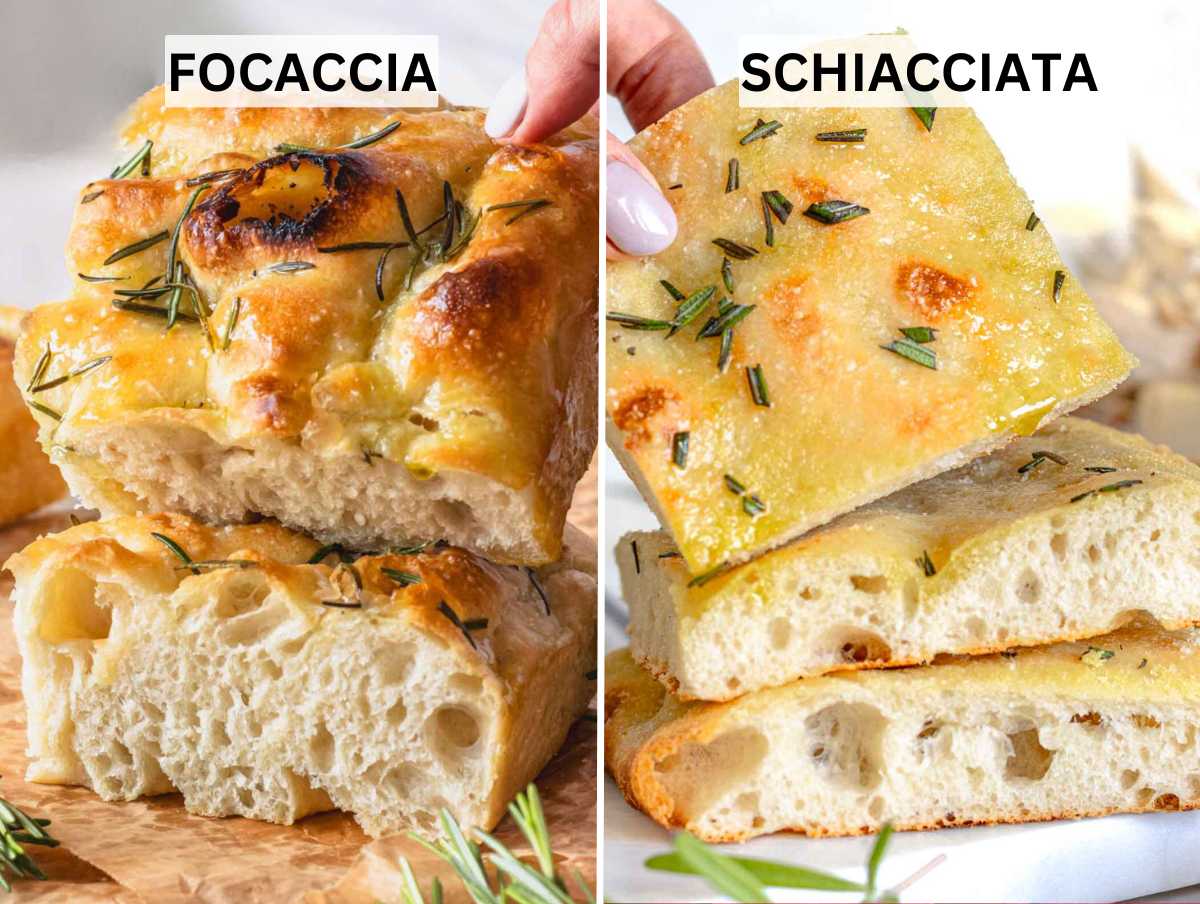
If you travel to Florence, you’ll see popular schiacciata shops like “all’ Antico Vinaio,” selling it cut-open and stuffed with local meats, cheese, and vegetables, similar to a focaccia sandwich.
Similar recipes: Focaccia pizza, flatbread pizza, Neapolitan pizza dough, Ooni pizza dough, quick pizza dough, and pizza dough recipe.
Ingredients for schiacciata
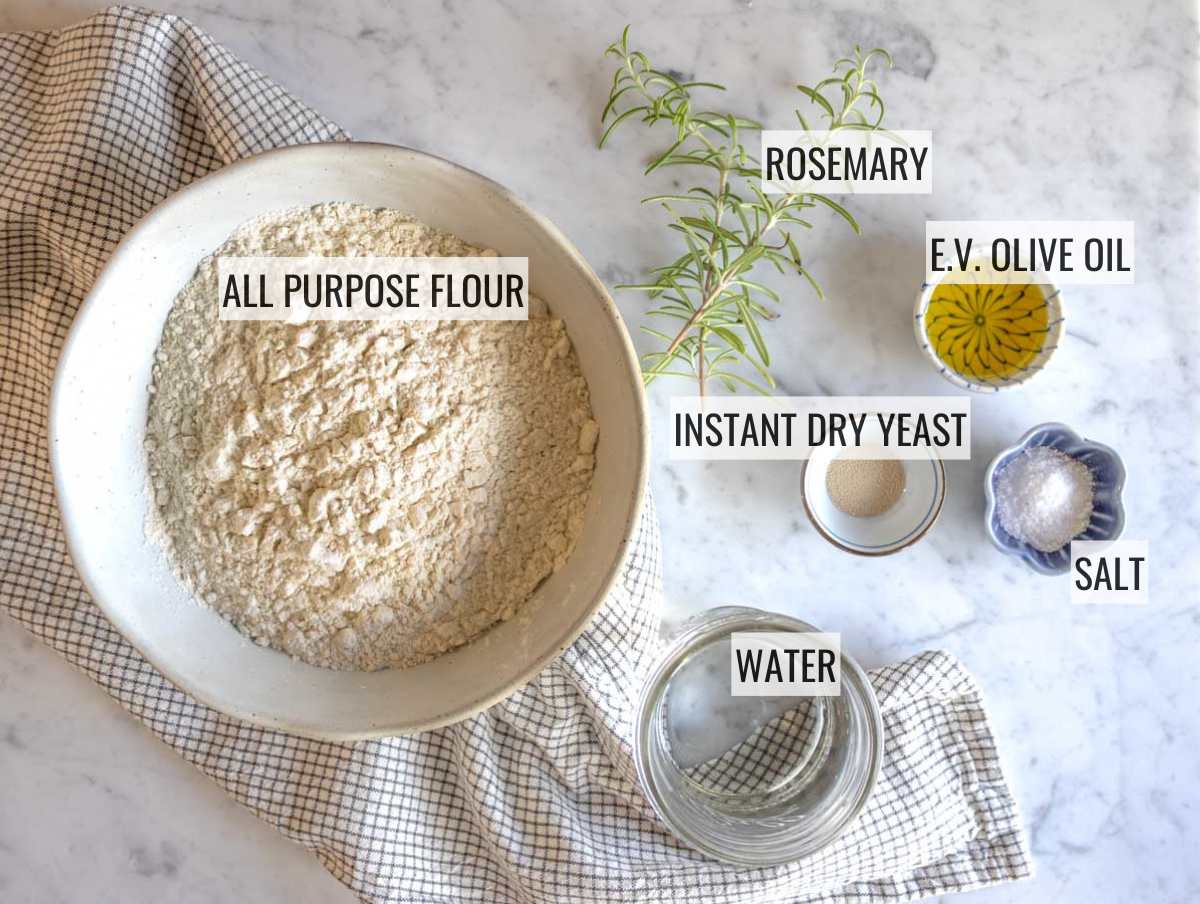
Quantities are in the recipe box at the bottom of the page.
Flour
You can make schiacciata with plain all-purpose flour.
You can substitute 00 flour, pizza flour, bread flour, or whole wheat flour for all-purpose flour.
Changing the flour changes the structure and texture of schiacciata.
For example, using 00 flour (a type of Italian flour used to make pizza) produces a lighter schiacciata with a shorter chewing time.
On the other hand, using whole wheat flour produces a heavier and more dense schiacciata.
Our favorite flour for making a quick schiacciata at home is Caputo Nuvola or Caputo Pizzeria flour, which can be found in larger supermarkets.
Water
Schiacciata’s hydration or water content varies from recipe to recipe, and there isn’t a fixed rule.
We use a relatively high water content, which is required when using a no-knead technique.
The water should not be hot, or you’ll risk deactivating the yeast.
Instant dry yeast
There are three types of yeast: instant dry yeast, active dry yeast, and fresh yeast. You can make schiacciata with any one of them.
We recommend instant dry yeast because it’s the most reliable and easy to use.
We extensively tested and trust the brands Caputo Dry Yeast, sold in a small green can, Red Star SAF instant, and Dr. Oetker instant yeast.
You can substitute fresh yeast for dry yeast. You’ll need three times more fresh yeast than dry yeast.
You can add a teaspoon of sugar to the yeast to help it activate. This is helpful if you are short on time and want to make schiacciata on the same day.
Extra virgin olive oil
Extra virgin olive oil has three functions:
- It makes the schiacciata soft
- It gives flavor
- It conducts heat and helps cook the bread faster
Since the oil gives flavor, choose a good quality one.
Salt
Salt is essential because it gives flavor and helps form structure. We recommend using sea salt.
Rosemary
Rosemary is optional. Some like to add it; some don’t. We love adding it.
You can use fresh rosemary or dry rosemary. I’d recommend adding it right after baking.
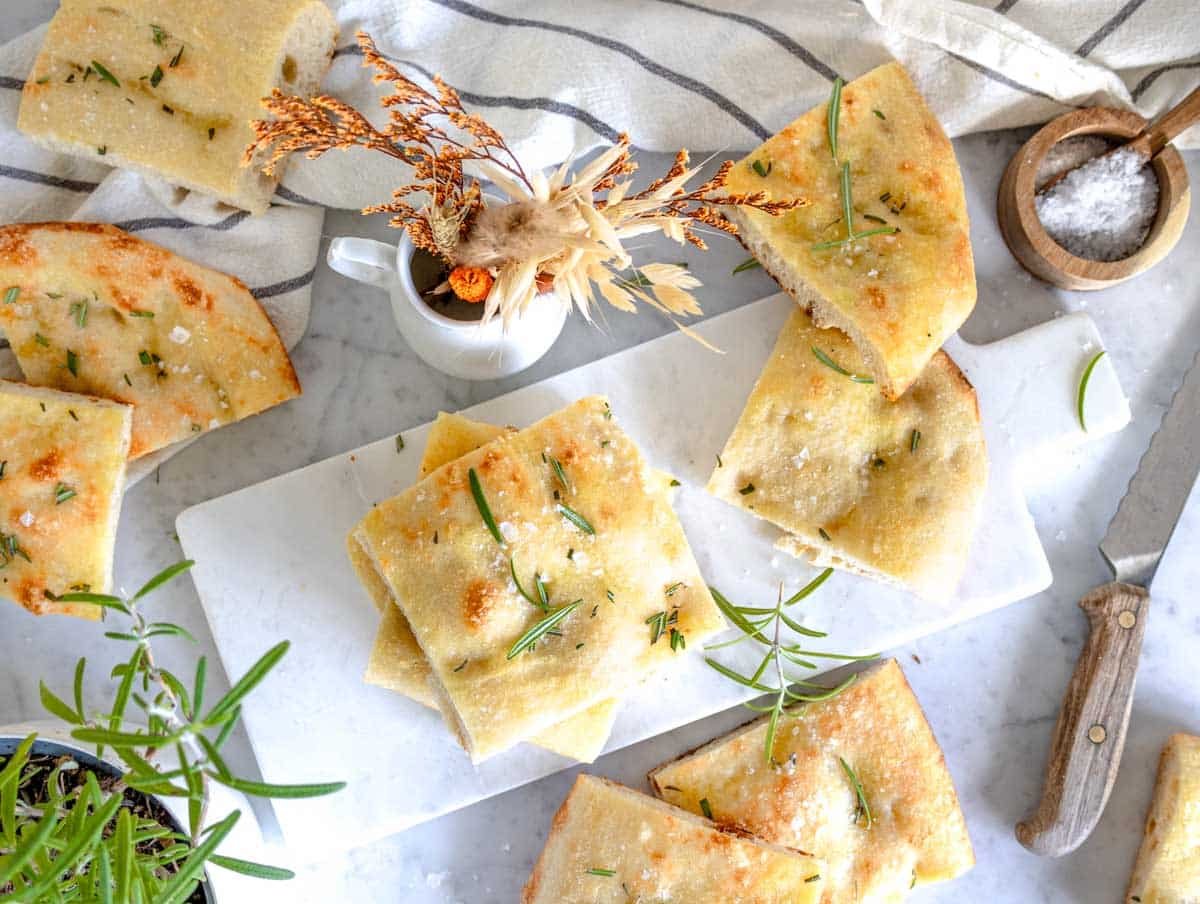
How to make schiacciata
1. Making the dough
To a large mixing bowl, add 1⅔ cups of lukewarm water, 2 teaspoons of instant dry yeast, and 2 teaspoons of sugar.
Whisk until the yeast is dissolved in the water. If it doesn’t dissolve, it might be inactive. My advice is to start over with new yeast.
Tip: The sugar helps activate the yeast and color the schiacciata as it bakes.
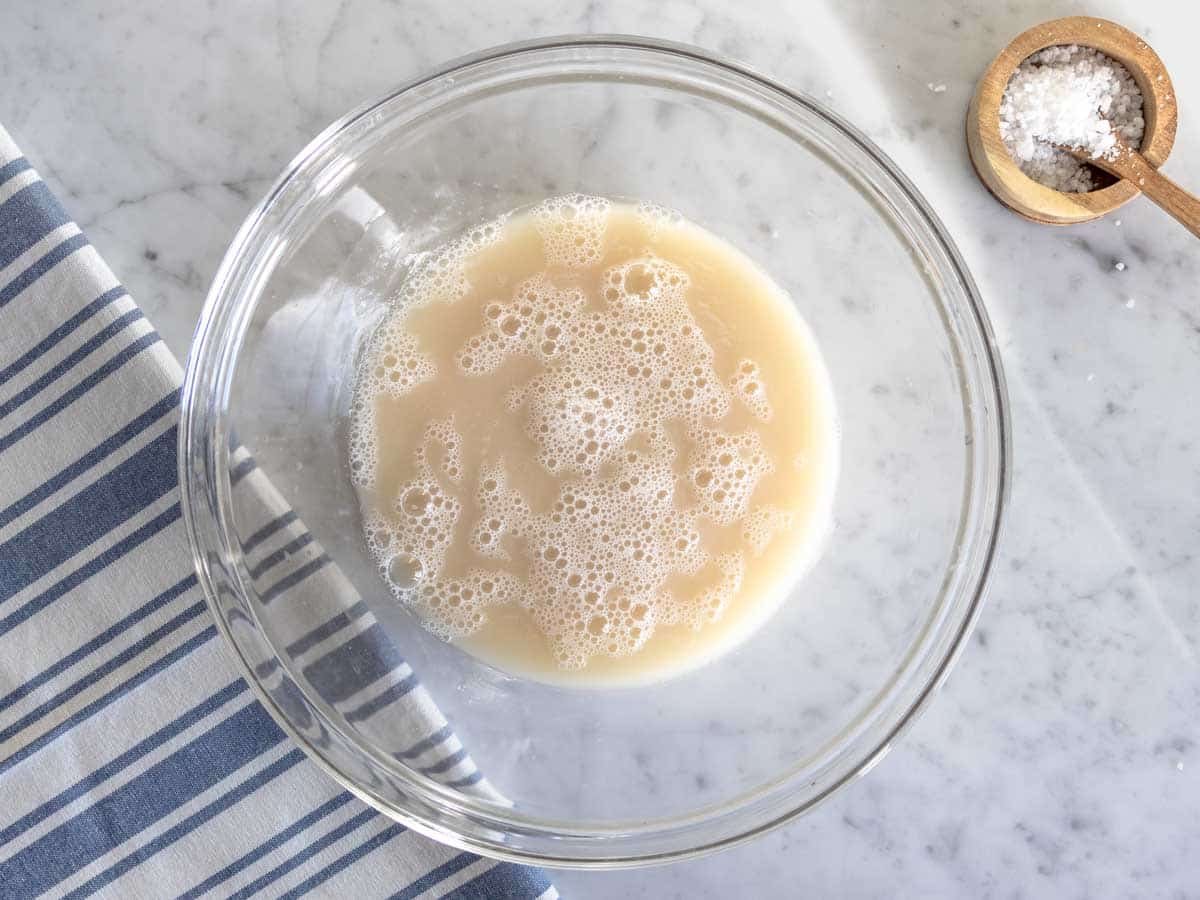
To the same bowl, add 3⅓ cups of flour and 2 teaspoons of salt.
Stir with a wooden spoon until combined. Then add 1 tablespoon of extra virgin olive oil and stir for another minute until the oil is incorporated into the dough.
Cover with plastic wrap, leaving enough space between the dough and the wrap.
Tip: I find it easier to stir the dough with a wooden spoon that I hold upside down. That is, stir with the handle of the spoon, not the actual spoon. Also, the dough should be wet and sticky at this stage and without a proper shape.
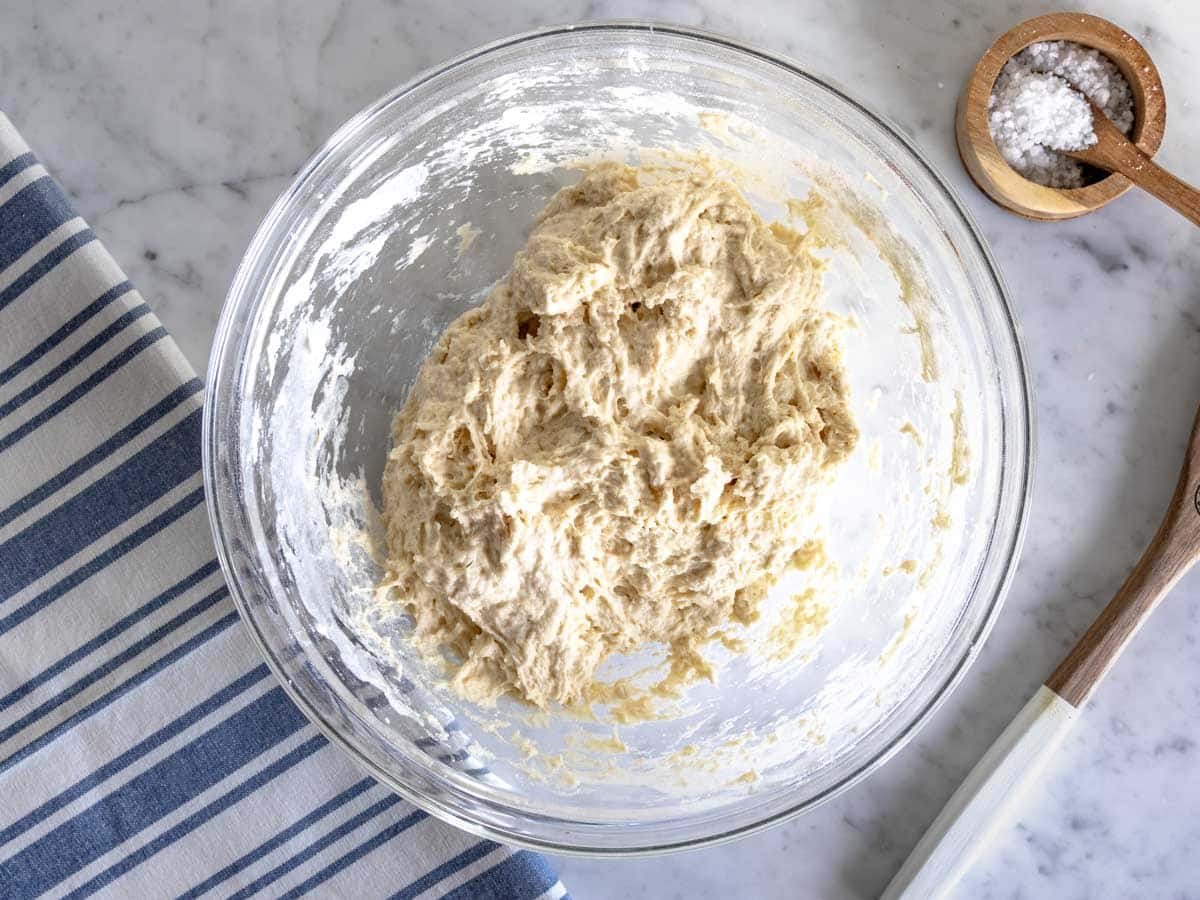
2. Proofing the dough
QUICK PROOFING: Let the dough proof in a warm corner of your kitchen for about 1½ hours or until it doubles in volume.
Tip: If your home temperature is below 68°F or 20°C, I recommend turning on your oven for 30 seconds and then turning it off. Put the dough in the slightly warm oven to create the perfect conditions (light heat + moisture) for the yeast to work.
SLOW PROOFING: Let the dough proof in the refrigerator for 8 to 36 hours.
After this time, remove the dough from the fridge and let it acclimatize to room temperature for about 2 hours before moving to the next step.
Which proofing is better? It depends. Quick proofing is excellent if you decide to make schiacciata at the last minute and want something delicious on the table in a few hours. Slow proofing is best if you have more time because the slow fermentation in the fridge allows the dough to build flavor and become more fragrant.
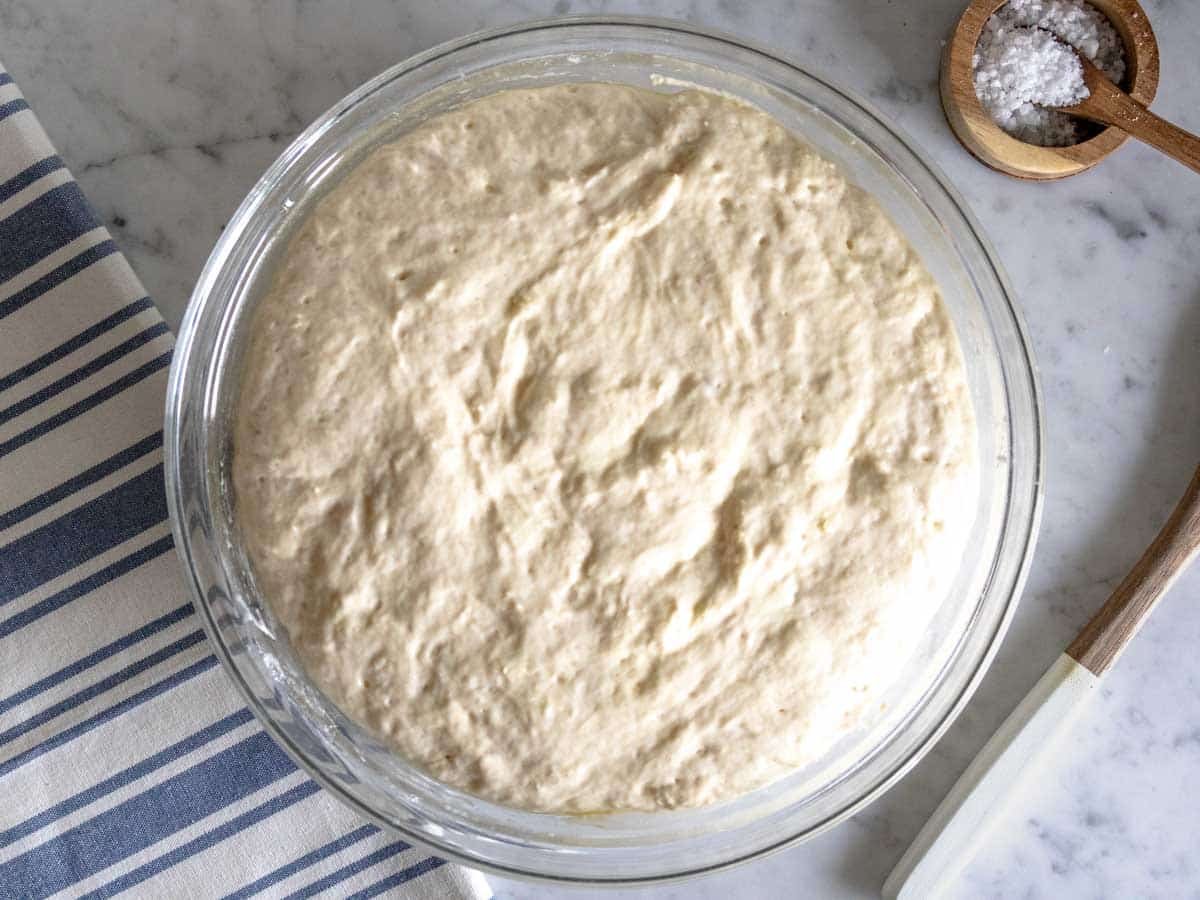
3. Folding the dough
Folding is essential to giving the schiacciata structure. This type of folding is the easiest.
While the dough is still in the bowl, fold it on itself with a spoon from the outside to the inside 20 times.
This process takes about 30 seconds to complete.
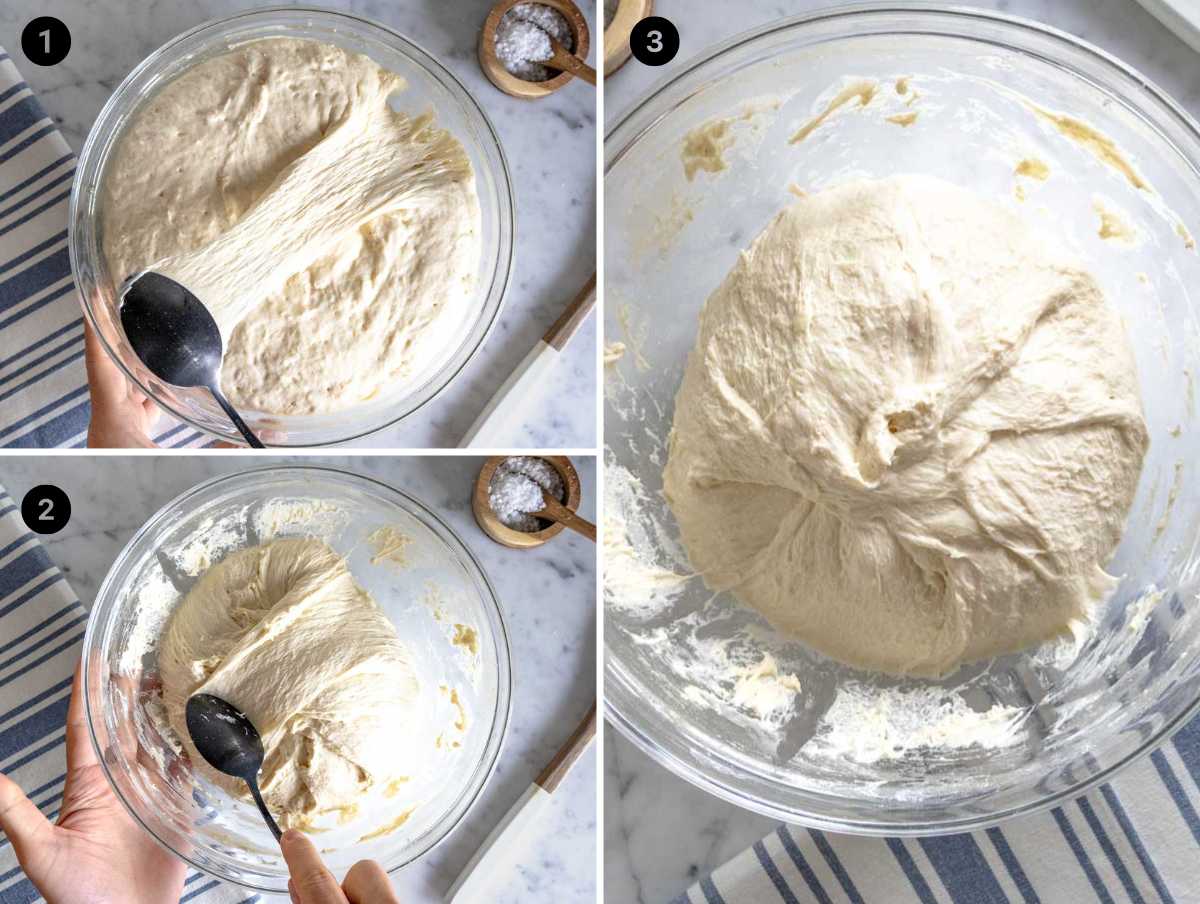
Flip the dough onto a baking tray lined with parchment paper and 1 tablespoons of olive oil.
Let it proof a second time, uncovered, in a warm spot in your kitchen for 45 minutes.
In the meantime, preheat the oven to 450°F or 230°C.
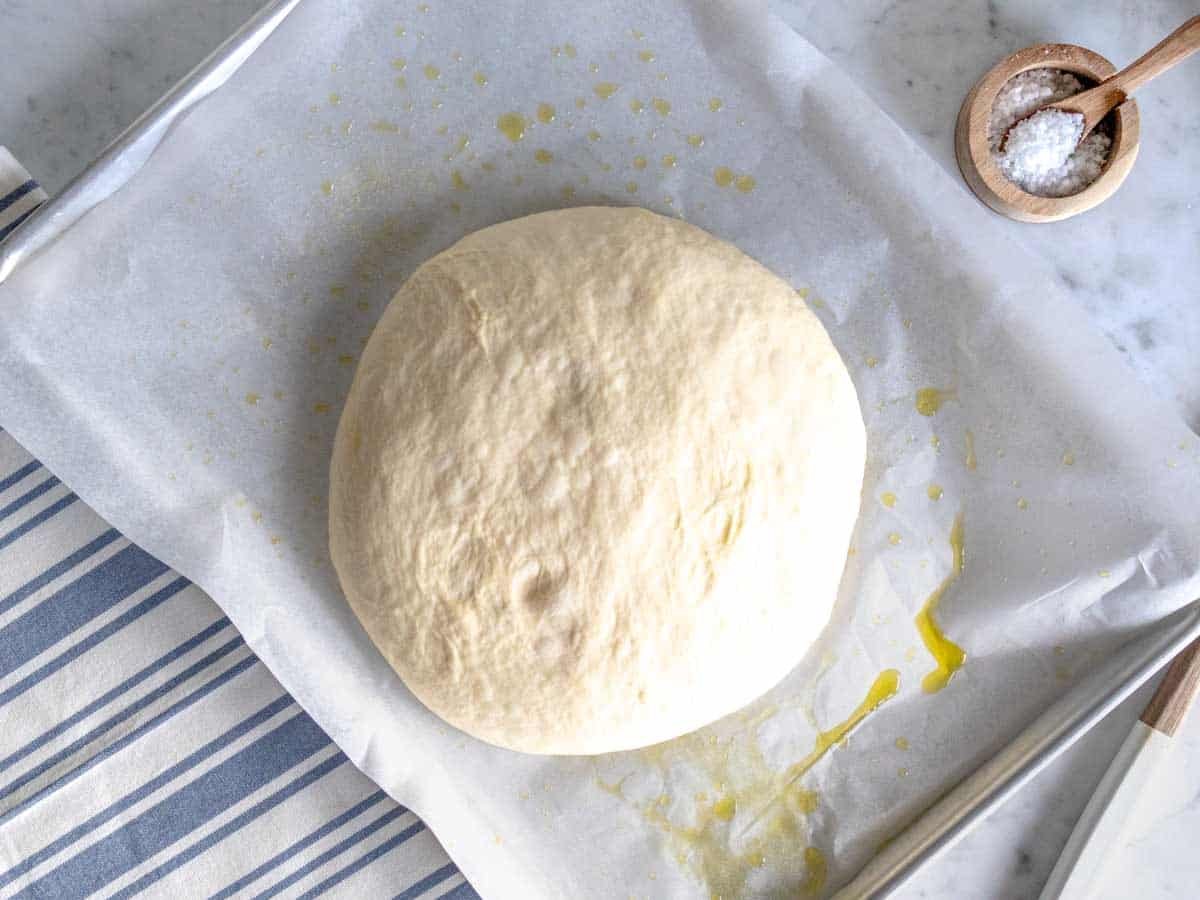
4. Flatten and bake
To flatten the dough, wet your hands first so it won’t stick.
Then, push down with your fingertips.
Aim to spread the dough through most of the baking tray.
Try to touch the dough as little as possible to preserve air bubbles.
Drizzle with 1 to 2 tablespoons of extra virgin olive oil and a few pinches of salt.
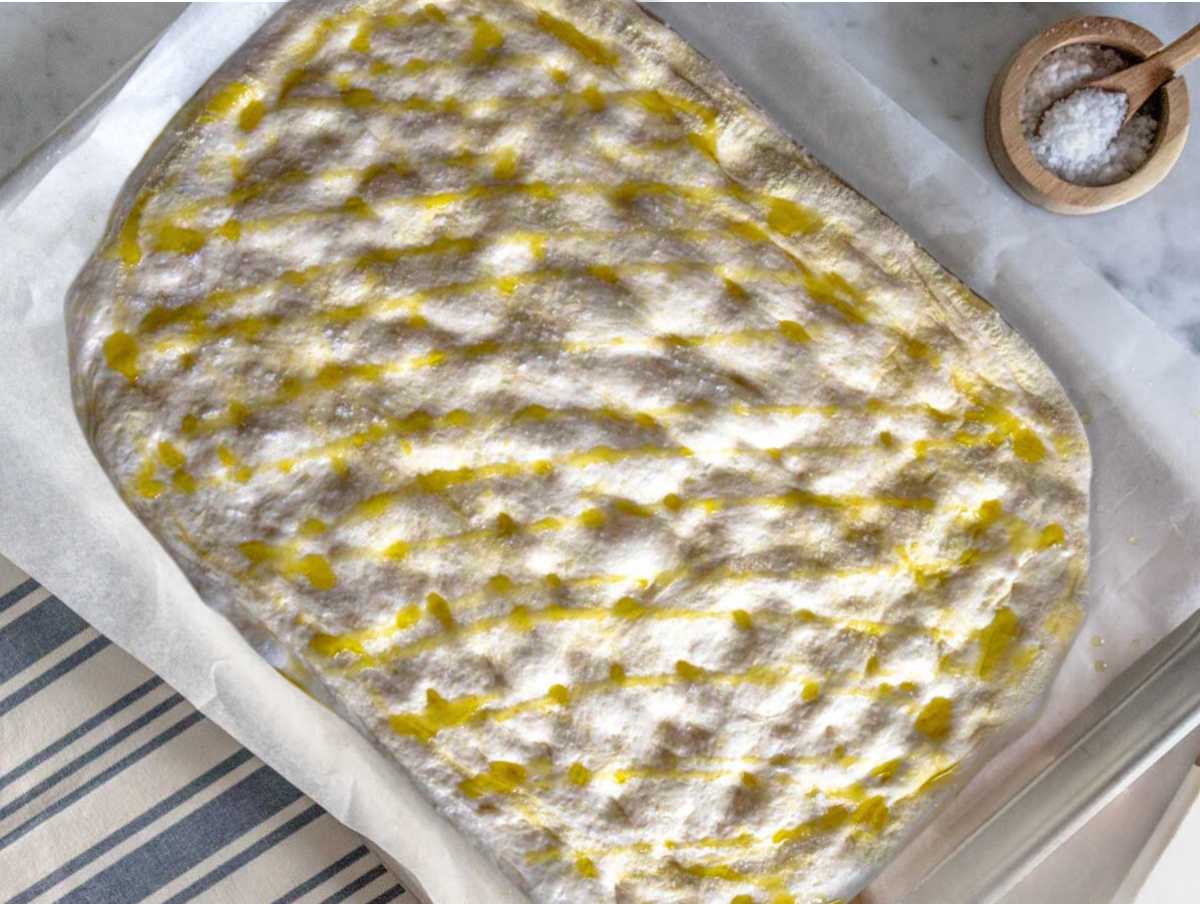
Bake on the lowest rack of your oven for about 18 to 20 minutes.
Remove from the pan and let it sit on a cooling rack for 30 to 60 seconds to steam out.
Optionally, you can top it with rosemary.

Serving suggestions
Schiacciata is versatile. It can be served instead of bread, for example, with soups, stews, or other dishes.
You can also have it as an afternoon snack.
It’s also great as an appetizer or to bring to potlucks and barbecues.
We love it dipped in hummus, pesto, white bean dip, romesco sauce, muhammara, and baba ganoush.
In Italy, schiacciata is often eaten as a late breakfast or mid-morning snack. It is usually cut in half and stuffed with Italian cold cuts, cheeses, and vegetables.
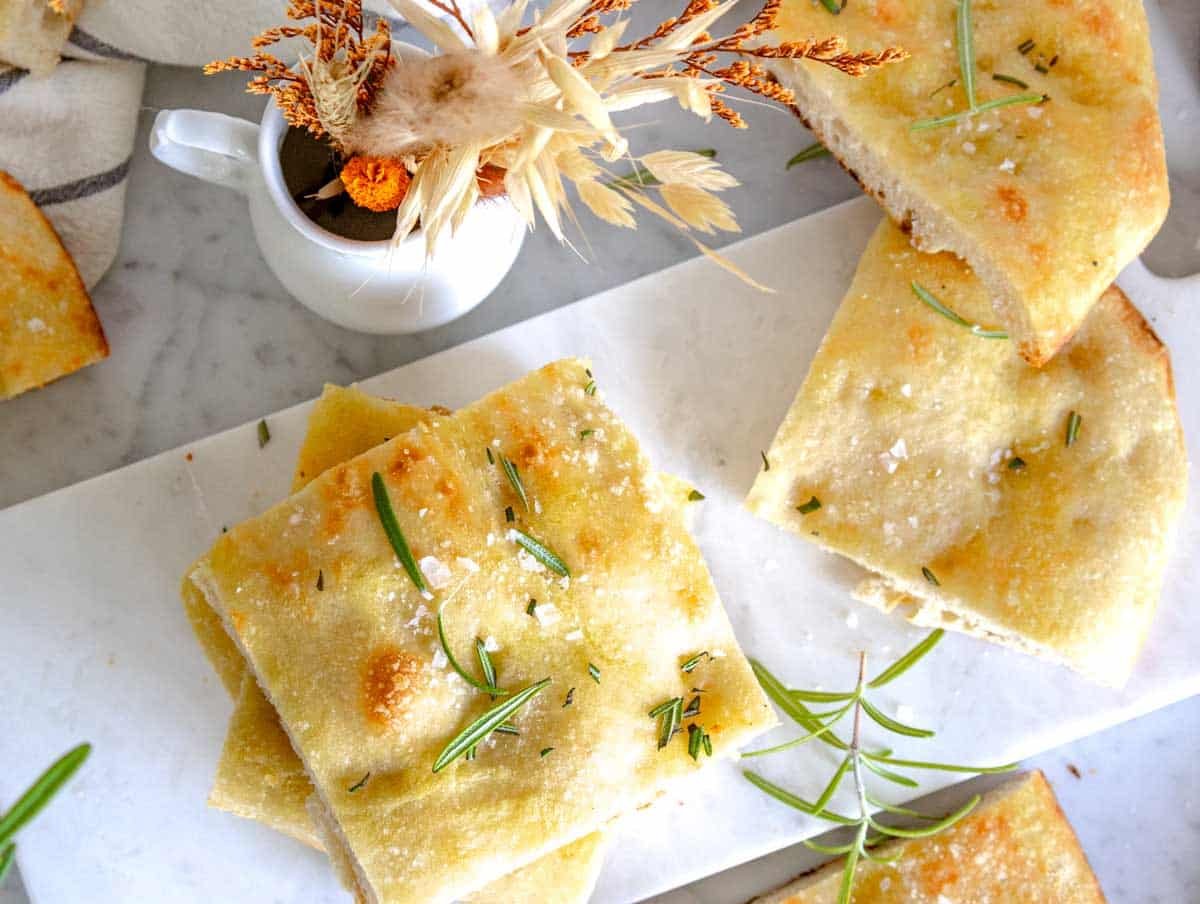
Tips
Flour: If you can find Caputo Nuvola flour or 00 pizza flour, that would make a delicious light focaccia.
Sugar: It feeds the yeast and helps color the schiacciata as it bakes.
Stirring: We find it easier to stir the dough with a wooden spoon, help upside down. That is, stir with the handle of the spoon, not the actual spoon.
Quick proofing: If your home temperature is below 68°F or 20°C, I recommend turning on your oven for 30 seconds and then turning it off. Then, put the dough in the slightly warm oven to proof, creating the perfect conditions (light heat + moist) for the yeast to do its work.
Temperature: When you bake schiacciata, the oven should be very hot. Preheat it to maximum temperature for at least 20 minutes.

Storage
Make ahead: If you want to make schiacciata in advance, I advise partially baking it for 12 minutes rather than the full 18 minutes and letting it cool on a cooling rack.
At this stage, you can freeze it wrapped in plastic for 3 months or store it in a plastic bag. Then, when you need it, finish baking it for 6 to 8 minutes in a preheated oven at 400°F or 200°C.
Room temperature: Keep leftovers in a plastic bag for 2 to 3 days.
Reheat: You can reheat it in the oven or air-fryer at 400°F or 200°C.
Freezer: See make ahead above.
Similar recipes
BREAD RECIPES: focaccia, focaccia pizza, Neapolitan pizza dough, quick pizza dough, flatbread pizza, pita bread, Naan bread.
TUSCAN RECIPES: Tuscan bean soup, bean stew, kale soup, panzanella, tortellini soup, vegetable soup, minestrone, biscotti, torta della nonna, crostata.
Bread Recipes
Focaccia Pizza
Bread Recipes
Focaccia
Bread Recipes
Pita Bread
Bread Recipes
Neapolitan Pizza Dough
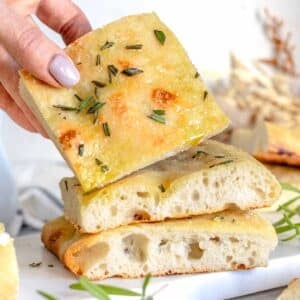
Schiacciata
Equipment
- We recommend using one half-sheet size pan (17 x 12 Inches or 43×30 cm). or two quarter-sheet size pans (12 x 9 Inches or 30 x 23).
Ingredients
- 1⅔ cups lukewarm water
- 2 teaspoons instant dry yeast
- 2 teaspoons sugar
- 3⅓ cups all-purpose flour or pizza flour
- 2 teaspoons salt + more for topping
- 1 tablespoon extra virgin olive oil + more for topping
- 1 teaspoon rosemary optional
Instructions
MAKING THE DOUGH
- To a large mixing bowl, add 1⅔ cups lukewarm water, 2 teaspoons instant dry yeast, and 2 teaspoons sugar. Whisk until the yeast is dissolved. If the yeast doesn't dissolve it might be inactive. Start over with new yeast.
- Add 3⅓ cups all-purpose flour and 2 teaspoons salt. Stir with a wooden spoon until combined. Add 1 tablespoon extra virgin olive oil and stir for another minute until absorbed. We are aiming for a wet and sticky dough.Cover the bowl with plastic wrap.
PROOFING
- QUICK PROOFING: Let it proof in a warm corner of your kitchen for about 1½ hours or until it doubles in volume. SLOW PROOFING: Let it proof in the fridge for 8 to 36 hours then remove from fridge and let 2 hours at room temperature.
EASY FOLDING
- While still in the bowl, fold the dough on itself with a spoon from the outside to the inside for 20 times. It takes one minute.
- Transfer dough onto a baking tray lined with parchment paper and olive oil. Proof a second time in a warm spot for 45 minutes.In the meantime preheat oven to 450°F or 230°C.
FLATTEN AND BAKE
- Wet your hands, then flatten dough with the tip of your fingers, filling the baking tray.You want to create dimples as you flatten the schiacciata.Drizzle with extra virgin olive oil (about 1 to 2 tablespoons) and sprinkle with salt to taste (about ½ to 1 teaspoon)
- Bake on the lowest oven rack for about 18 to 20 minutes. Remove from the pan and let it steam out on a cooling rack for 30-60 seconds before cutting it.Optionally you can top with rosemary.


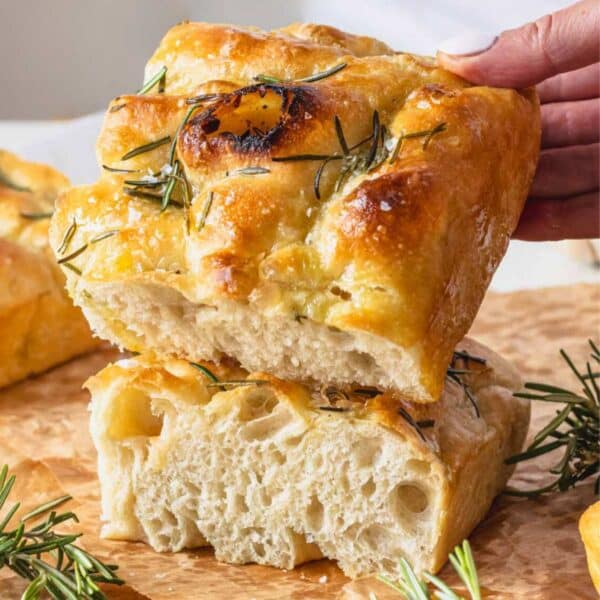
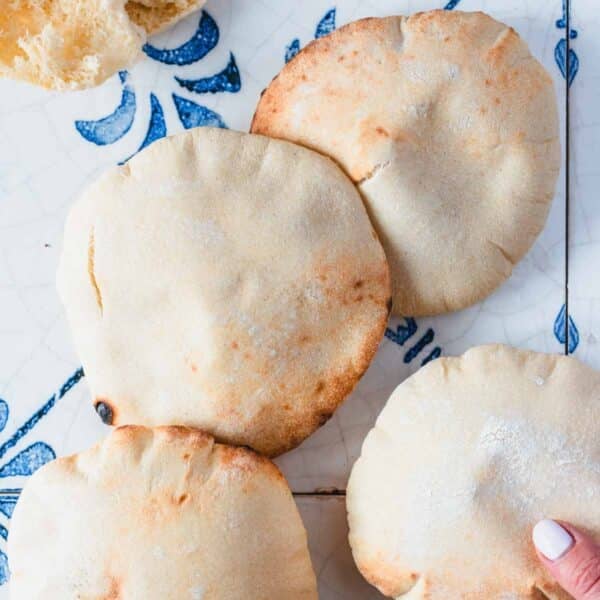

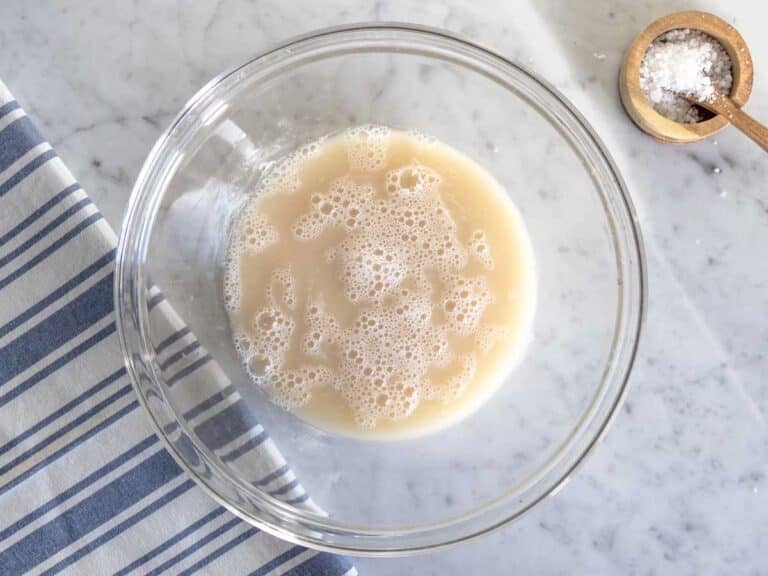
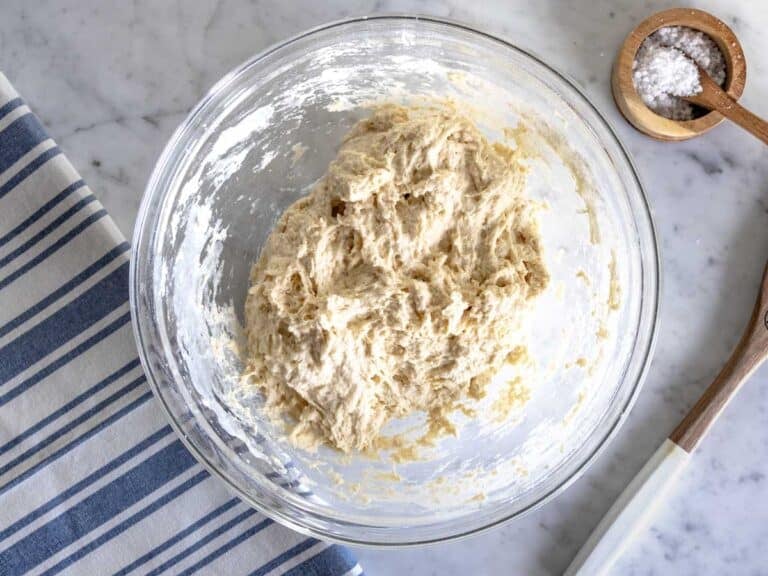
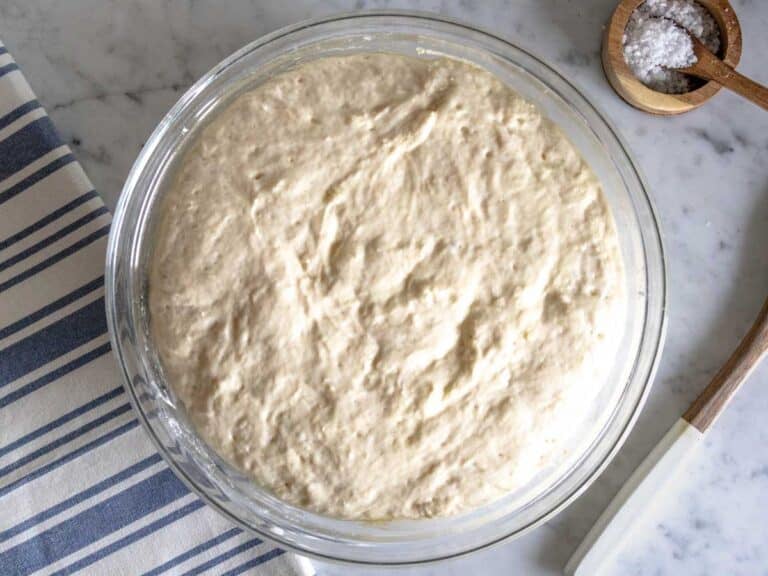

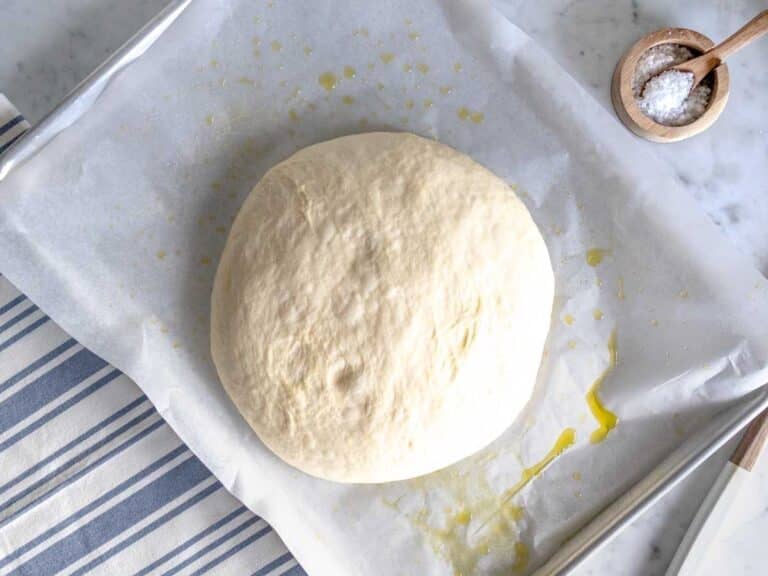
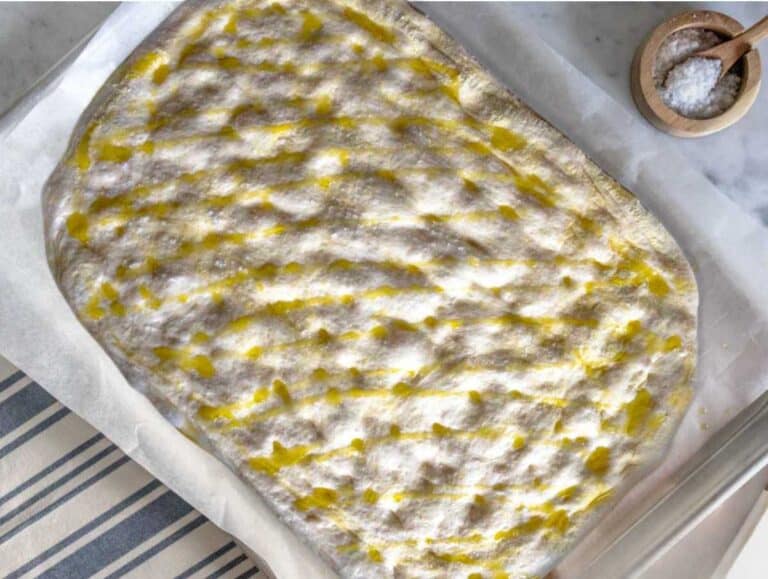
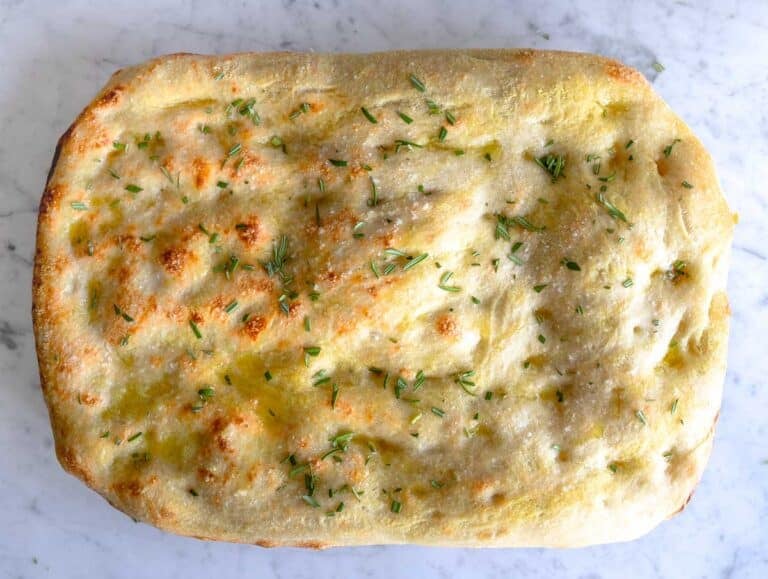

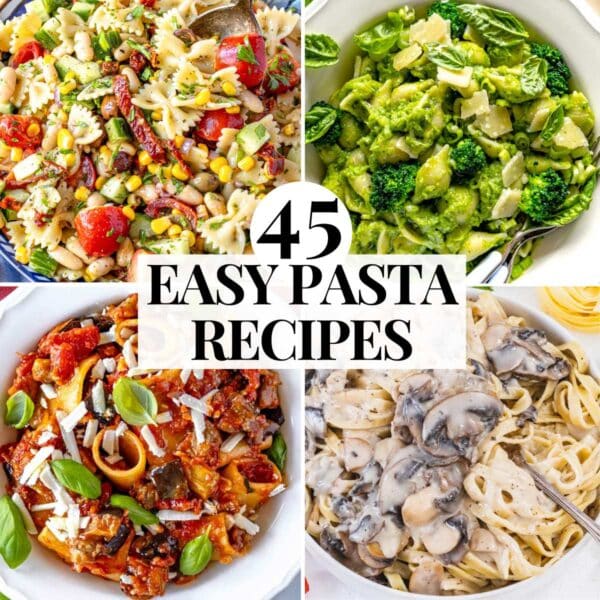



Thank you so much for sharing this awesome recipe. I never leave reviews but this was so good. Such an easy addition that makes a soup into a meal and disappears quickly.
I made this with AP flour with 2 tbsp of vital wheat gluten mixed in as I didn’t have bread flour and the result was a perfectly chewy bread. Tried both the long ferment and quick version and both are great.
Added roasted garlic with the rosemary and oil topping and it was like something you might get at a good restaurant. If you want to make something impressive that is also simple give this recipe a try!
That’s great, Heath, I’m really happy that you tried it!! This is Nico’s grandmother’s recipe, she would have been so happy to hear that you made her bread 🙂
Thanks so much for taking the time to leave a review here, we really appreciate it. Kindest,
Louise
Made this recipe already 3 times and never fails . It’s become my go to . Easy , and delicious !! Thank you !!
Made this today for dinner with a vegetable lemon soup, and lashings of parmesan on top! But the bread stole the show!
My 3 year old and 8 year old loved it.. and I sent some to a friend who had her car stolen.. hopefully it will cheer her up a bit! It was absolutely delicious.. it will definitely be a regular in our house !!!! Thank you so much !
Your recipes are my go to everytime!
Love Jaz xx
Hi Jazmine,
That sounds like a wonderful meal, what a great idea with the pairing of a lemon soup with parmesan 😋
Thanks so much for taking the time to write your feedback here, and all the best for 2025 to you and your family.
Yummy